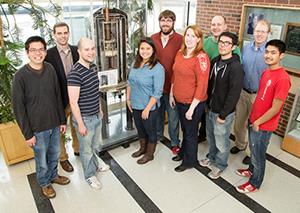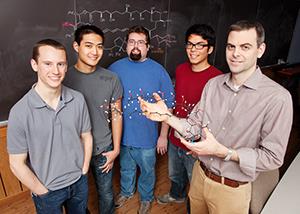Fighting a Deadly Cure

It’s hard to know what’s more frightening: invasive fungal infections, which kill half of the 3 million people afflicted with them every year, or amphotericin, the drug that’s been used to fight the infections even though it’s nearly as deadly as the infections themselves.
Researchers in the Department of Chemistry, however, have solved a decades-old medical mystery by finally understanding the functions of amphotericin—nicknamed “amphoterrible” for its potent side effects—and discovered a potentially less toxic way to fight the invasive fungal infections.
Scientists have long sought solutions to make amphotericin less toxic, but the drug has been so hard to study that no one knew exactly how it worked.
“This molecule is one of the most challenging to work with because it has a very complex structure, is poorly soluble, and is sensitive to light, oxygen, and acid,” says University of Illinois and Howard Hughes Medical Institute chemistry professor Martin Burke, who led the study with chemistry professor Chad Rienstra.
Amphotericin also interacts with cell membranes, which are notoriously difficult to study. Many labs, including Burke’s, have tried to figure out the three-dimensional structure of amphotericin by crystallizing it, a standard technique. So far, all attempts have failed.
So the team turned to solid-state nuclear magnetic resonance (NMR) spectroscopy, which is one of the most powerful tools for studying non-crystalline samples. It measures how atomic nuclei respond to changes in a magnetic field. Rienstra, who led the NMR work with graduate students Mary Clay and Tom Anderson, says they developed several new NMR experiments to study amphotericin in the presence of membranes.

Previous studies had found evidence that amphotericin opens up ion channels in membranes, perhaps making them more susceptible to charged atoms, which could disrupt a cell. Most scientists assumed that this was the drug’s main mode of action.
But the evidence also suggested that amphotericin interacts with sterols, such as cholesterol in animal cells and ergosterol in yeast. Rienstra and Burke focused on amphotericin’s influence on sterols, hypothesizing that this might be a key to its toxicity.
The initial NMR data supported this idea, indicating that very little of the drug—less than 5 percent—actually formed channels in membranes. Using NMR and other experimental tools, the Rienstra/Burke team found that most of the amphotericin aggregates on the exterior of membranes, extracting sterols out of membranes like a sponge. Cell death follows soon after.
The new understanding allowed the researchers to focus on how to make amphotericin less toxic. In a separate study, Burke and his colleagues developed a derivative of amphotericin that, at least in cell culture, binds to ergosterol in yeast but not to human cholesterol.
Preclinical trials of the new compound have begun. The National Institutes of Health and the Howard Hughes Medical Institute supported portions of this work.
“We are very excited about this discovery,” Burke says. “But a great deal of work lies ahead to see if this compound has the potential to serve as a less toxic treatment for fungal infections in human patients. At this point, we just have a very promising compound.”








